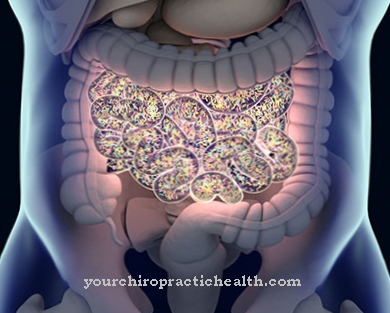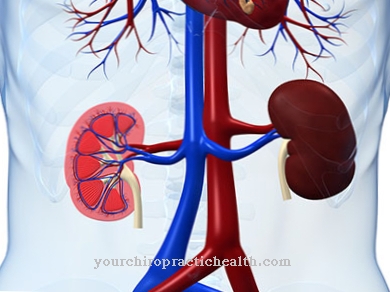As Lenz-Majewski syndrome the doctor knows a type of hyperostotic short stature, which is associated with a cutix laxa and osteosclerosis. The syndrome is based on a mutation in the PTDSS1 gene at gene locus 8q22.1. A causal therapy is not yet available to those affected.
What is Lenz Majewski Syndrome?

© deepagopi2011 - stock.adobe.com
The Lenz-Majewski syndrome is a special and extremely rare form of short stature. The symptom complex has so far only been described in nine cases. As a syndrome from the group of hyperostotic short stature, the complex is not only characterized by short stature, but also by characteristic facial features and a cutis laxa. Progressive bone sclerosis was also observed in the newly described cases.
Progressive sclerosis is also known as osteosclerosis and corresponds to hardening of the bone tissue. The prevalence of Lenz-Majewski syndrome is assumed to be only one case in one million people. The clinical terms are synonyms for the symptom complex Braham-Lenz Syndrome and Lenz-Majewski hyperostotic dwarfism.
The first synonym goes back to the first descriptor Braham. In his remarks in the 20th century he still referred to the syndrome as Camurati-Engelmann Syndrome. A little later, the German human geneticist Lenz and the pediatrician Majewski carried out an initial delimitation. The name of the disease as Lenz-Majewski syndrome refers to this first delimitation towards the end of the 20th century.
causes
Lenz-Majewski syndrome has a genetic cause. The cases observed so far do not seem to have occurred sporadically, but are subject to an autosomal dominant inheritance. The old age of the fathers of affected children, in particular, points to autosomal dominant new mutations as the primary cause of the symptoms.
In the meantime, despite the few cases described, the causative gene has been identified. The syndrome is probably based on a mutation in the PTDSS1 gene, which is located at the gene locus 8q22.1. The gene codes for a protein called phosphatidylserine synthase 1.
Due to the mutation of the gene, the protein loses its function, which consists in the formation of phosphatidylserine. Phosphatidylserines are important phospholipids that are counted among the membrane components. This connection seems to trigger the extreme short stature with pathologically altered vertebral bodies.
Symptoms, ailments & signs
Patients with Lenz-Majewski syndrome suffer from various clinical criteria. The disease manifests itself in early infancy and occurs during this time as a failure to thrive. Patients appear pre-aged and progeroid. Your skull sutures are unusually wide. The same goes for her fontanel. Often immediately after birth, craniofacial dysmorphism is noticeable.
Most patients have a prominent and extremely broad forehead. In addition, there is often hypertelorism. The tear ducts of those affected are often more or less obstructed in their course. The auricles appear excessively large and noticeably slack. There are usually defects in the enamel of those affected, which later promote tooth decay. The aged appearance of those affected can be traced back to a so-called cutis laxa.
This phenomenon corresponds to thin and withered skin, which is increasingly characterized by veins and is associated with hernias, cryptorchidism or hypospadias. Most patients suffer from mental retardation. On the fingers, the syndrome manifests itself as membranous syndactylies that usually affect the space between the second and fifth fingers.
The severe short stature is the most characteristic symptom of Lenz-Majewski syndrome. Under certain circumstances, the limbs of the person affected are also affected by brachydactyly and appear greatly shortened.
Diagnosis & course of disease
In order to make an initial suspected diagnosis of Lenz-Majewski syndrome, the doctor usually only needs the clinical picture. In addition, an X-ray image can be arranged. The imaging shows typical criteria such as progressive osteosclerosis on the skull bones and vertebral bodies. This sign can be associated with broad ribs or collarbones.
In addition, diaphyseal sclerosis with a broadening of the bones can be seen in the X-ray. Hypoplasia of the middle phalanges also speaks for the syndrome. In terms of differential diagnosis, the doctor must differentiate the syndrome from symptom complexes with a similar appearance, for example Camurati-Engelmann syndrome, craniodiaphyseal dysplasia or craniometaphyseal dysplasia.
A molecular genetic test can be carried out to confirm a suspected diagnosis. If the patient actually suffers from Lenz-Majewski syndrome, this analysis provides evidence of the genetic mutation.
Complications
With Lenz-Majewski syndrome, those affected primarily suffer from short stature. In children, this complaint can lead to mental health problems or bullying and teasing. The quality of life of the person affected is considerably reduced by this disease. Furthermore, it is not uncommon for tooth decay and other defects to occur.
Without treatment, those affected suffer from severe toothache and other unpleasant symptoms in the oral cavity. It is not uncommon for Lenz-Majewski syndrome to lead to mental retardation, so that the patients are dependent on the help of other people in their everyday lives. Often the parents and relatives of those affected also suffer from the symptoms of psychological complaints or depression.
Furthermore, individual extremities can be shortened as a result of the disease, which can also lead to various restrictions in life. It is not possible to treat Lenz-Majewski syndrome causally. For this reason, treatment is primarily aimed at reducing the individual symptoms. There are no complications, but the course of the disease is not completely positive. As a rule, those affected by Lenz-Majewski syndrome are dependent on the help of other people for their entire life.
When should you go to the doctor?
Patients with Lenz-Majewski syndrome experience various symptoms that need to be clarified. Since the disease is hereditary, symptoms can be diagnosed shortly after birth. Parents should consult a doctor closely if there are any symptoms or complications. If the child develops emotional problems as a result of the malformations and skin changes, a therapist must be called in. Complications due to any mental complaints should also be clarified by a specialist.
It is best for parents to keep in touch with a specialist clinic for genetic diseases. Other doctors should be consulted if the child shows signs of visual disturbances or discomfort in the mouth. The characteristic short stature must be treated by an orthopedic surgeon. If the Lenz-Majewski syndrome is treated early, the symptoms can be greatly alleviated. Therefore, an early diagnosis is necessary, even if the symptoms of hyperostotic short stature may not be very pronounced at the beginning. After the initial treatment, the child still needs the help of physiotherapists, psychologists and doctors.
Treatment & Therapy
So far, there are no causal therapeutic approaches available for patients with Lenz-Majewski syndrome. However, gene therapy methods of treatment are currently an object of medical research. Depending on the progress of this research topic, there may be gene therapy causal healing options for the syndrome in the future. Currently, however, those affected have to be satisfied with symptomatic treatment.
This symptomatic treatment can include, for example, surgical correction of the malformations. Such a correction does not always have to take place, but is limited to syndactylies that restrict the patient in his everyday life. The progressive hardening of the bones can be slowed down under certain circumstances through dietary and medical interventions.
The osteosclerosis should be monitored constantly and closely so that any fractures can be treated quickly. Because of the mental and intellectual deficits, the affected patients are usually recommended early intervention. As part of this early intervention, any deficits at the intellectual level can ideally be reduced so that they are moderate and are hardly noticeable. The parents of affected children should ideally receive detailed advice on possible funding opportunities.
Outlook & forecast
The prognosis for Lenz-Majewski syndrome is poor. According to the current medical and scientific status, there is no therapeutic option that leads to recovery. The cause of the health disorder is based on a genetic defect. Since changes in human genetics cannot be made for legal reasons, there is no way to correct the mutation.
The further course of the disease depends on the severity of the individual complaints. Nevertheless, in a patient with the syndrome, the quality of life is generally considerably restricted. Even if the symptoms are mild, there are abnormalities in the growth process. Short stature is characteristic of the disease. This cannot be corrected even with the administration of hormones. The visual flaw leads to a state of emotional distress. For this reason, the risk of psychological complications is increased for those affected.
In the case of a severe course of the disease, there are also cognitive limitations in addition to the physical abnormalities. The mental retardation can already be supported in the first years of life by early support. The overall cognitive performance is then improved, but there is a possibility that limitations in the performance level will remain for life. The deficits can be minimized with the help of a therapist and the support of relatives. This enables some patients to lead a good life.
prevention
The Lenz-Majewski syndrome cannot be prevented so far, as the symptom complex is caused by a genetic new mutation for an unspecified reason.
Aftercare
Since Lenz-Majewski syndrome is incurable, regular and comprehensive follow-up care is required. Those affected usually suffer from a number of complications and complaints, which in the worst case can lead to the death of the person concerned. The disease should therefore be recognized very quickly in order to contain further complaints or complications.
Sufferers should see a doctor regularly to review medication settings and possible side effects. Since the disease can be very stressful for the person affected and their relatives, psychological support can be recommended in order to generally alleviate the suffering.
You can do that yourself
It is not possible to treat Lenz-Majewski syndrome by means of self-help. As a rule, direct medical treatment of the syndrome is not possible either, as it is a hereditary disease.
If the person concerned has intellectual deficits, these must be remedied through intensive support. The earlier this funding begins, the higher the probability of compensating for these deficits. The parents can also do various exercises with the child in their own home in order to promote and strengthen the spirit. However, the child should also be given intensive support in kindergarten and school.
The hardening of the bones can be relieved by taking medication. It is important to ensure that it is taken regularly, although parents should pay attention to this regularity, especially with children. The hardening can also be stopped through an adapted diet. Here, however, the exact instructions of the doctor about a special diet must be observed. The malformations are corrected by surgical interventions and cannot be treated by means of self-help.


.jpg)
.jpg)




.jpg)



















